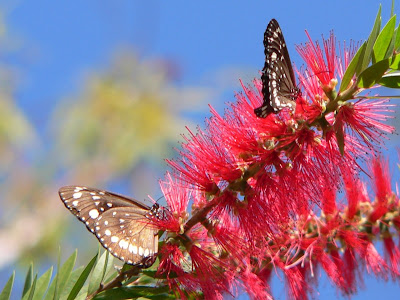Continuing the theme of red in nature, today's the turn of plants. As with animals, plants generally show red to be noticed. Probably the most obvious manifestation of this is in flowers; the entire purpose of a flower is to attract a pollinator, which is then persuaded by means of a bribe - usually an energy hit in the form of sugar, ie nectar - to venture where it will inadvertently collect pollen to take to another flower. Insects in general see best in the shorter wavelength end of the colour spectrum - blues, purples, yellows - so red flowers are primarily bird-pollinated.
Australia appears to have an unusually high proportion of bird-pollinated flowers relative to other parts of the world, though work coming out of southern Africa and South America suggests that numbers there are higher than hitherto recognised. Here a few plant families provide a high proportion of bird-pollinated flowers; these are especially Proteaceae, Myrtaceae, Epacridaceae (Australian heaths, sometimes now placed in Ericaceae, the Old World heaths), Fabaceae (peas) and Myoporaceae (mainly Eremophila, though this genus is now sometimes included in Scrophulariaceae). Honeyeaters are by far the major pollinators, followed by the lorikeets, but many other bird families are involved. Here are some examples of the flowers.
 |
| Scarlet Banksia Banksia coccinea, Proteaceae Stirling Ranges NP, Western Australia. |
 |
| Grevillea wickhamii, Proteaceae Bladensburg NP, Queensland. |
 |
| Waratah Telopea speciosissima Proteaceae Carrington Falls, southern New South Wales. |
Proteaceae is an old Gondwanan family, and in South America in particular similar genera occur.
 |
| Notro Embothrium concinnum Proteaceae Laguna Verde, southern Chile. Its main pollinators are hummingbirds and elaenias, generally thought of as flycatchers. |
 |
| Mottlecah, Eucalyptus macrocarpa, Myrtaceae north of Perth, Western Australia. |
 |
| Eremophila glabra Myoporaceae (but see comment above) Shark Bay Western Australia. |
 |
| Running Postman Kennedia prostrata Fabaceae Coffin Bay NP South Australia |
 |
| Epacris longifolia Epacridaceae (but see comment above) Morton NP, New South Wales. |
 |
| Lechanaultia formosa Goodeniaceae Stirling Ranges NP, Western Australia. |
In northern South America hummingbirds dominate pollination and they too are attracted to red.
| Bomeria sp. Alstroemericaceae El Cajas NP, southern Ecuador |
| Fuchsia ampliata Onagraceae Yanacocha Reserve near Quito, Ecuador |
| Epidendrum ardens Orchidaceae Manu National Park southern Peru - 4000 metres above sea level. |
All of this is not of course to say that insects do not visit red flowers - they certainly do.
 |
| Common Crows Euploea core on Callistomen viminalis Undarra NP Queensland |
Whether they respond to scent - not likely, given that birds generally don't rely on it much, unless some red flowers also seek to attract them as a back-up - or simply recognise the flower from other cues, is not known, at least to me.
There are other plant parts that turn red too; I was going to talk about them today, but this has alreddy gone on long enough I think, so I'll pop back tomorrow to finish off.


















